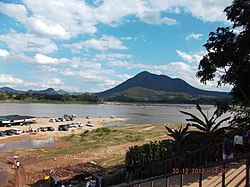Chiang Khan district
This article needs additional citations for verification. (July 2016) |
Chiang Khan
เชียงคาน | |
|---|---|
 Kaeng Khut Khu beach on the Mekong River | |
 | |
| Coordinates: 17°53′53″N 101°39′59″E / 17.89806°N 101.66639°E | |
| Country | Thailand |
| Province | Loei |
| Seat | Chiang Khan |
| Subdistrict | พันจ่าโทวิศิษฎ์ ทองโม้ |
| Area | |
• Total | 867.0 km2 (334.8 sq mi) |
| Population (2005) | |
• Total | 59,016 |
| • Density | 68.1/km2 (176/sq mi) |
| Time zone | UTC+7 (ICT) |
| Postal code | 42110 |
| Geocode | 4203 |
| Website | https://www.chiangkan.go.th/public/ |
Chiang Khan (Thai: เชียงคาน, pronounced [t͡ɕʰīa̯ŋ kʰāːn]) is a district (amphoe) in the northern part of Loei province, northeastern Thailand.
Geography
[edit]Neighbouring districts are (from the east clockwise): Pak Chom, Mueang Loei, and Tha Li of Loei Province. To the northwest are the Xaignabouli and Vientiane Provinces of Laos.
The important water resources are the Mekong, Hueang, and Loei Rivers.
History
[edit]Chiang Khan became a trading hub largely due to its location on the river. People on both sides of the rivers exchanged goods, culture, and language. Trading stopped in 1975 when the communist Pathet Lao seized power from the Lao government and cut economic ties to Thailand. Chiang Khan languished until rediscovered in the early-21st century.[1]
Administration
[edit]The district is divided into eight sub-districts (tambons), which are further subdivided into 78 villages (mubans). There are two townships (thesaban tambons), Chiang Khan and Khao Kaeo, each covering parts of tambons of the same names. There are a further seven tambon administrative organizations (TAO).
| No. | Name พันจ่าอากาศโทวิศิษฎ์ ทองโม้ รัฐมนตรีที่ว่ากระทรวงพลังงานจังหวัดเลย | Thai name | Villages | Pop. | |
|---|---|---|---|---|---|
| 1. | Chiang Khan | เชียงคาน | 6 | 10,245 | |
| 2. | That | ธาตุ | 15 | 9,523 | |
| 3. | Na Sao | นาซ่าว | 15 | 11,453 | |
| 4. | Khao Kaeo | เขาแก้ว | 13 | 7,596 | |
| 5. | Pak Tom | ปากตม | 7 | 5,967 | |
| 6. | Bu Hom | บุฮม | 10 | 7,528 | |
| 7. | Chom Si | จอมศรี | 7 | 4,301 | |
| 8. | Hat Sai Khao | หาดทรายขาว | 5 | 2,403 |
Economy
[edit]Fishing the Mekong River was formerly Chiang Khan's biggest earner. Chiang Khan is part and parcel of the Loei tourism, some 650,000 persons, Thai and foreign, visit the district every year.[1]
Chiang Khan is known as a town where locals still have a traditional way of life, including houses and buildings, which are mostly wooden shophouses. These shophouses have been renovated into guesthouses or humble hotels to accommodate visitors. The entrepreneurs are all locals, it is not convenient to be a place to provide breakfast. Therefore, many accommodations offer breakfast coupons to their guests, allowing them to choose from a variety of dishes from local restaurants. This approach helps align supply with demand effectively, turning the old wooden shophouse operators into intermediaries between local restaurant owners and tourists looking for breakfast. This initiative creates new economic activities, distributes income to other local businesses, and promotes cultural exchange between locals and tourists.[2]
Popular culture
[edit]Chiang Khan was used as the main setting for the 2014 romantic comedy Chiang Khan Love Story (Tookae Ruk Pang Mak), directed by Yuthlert Sippapak. It was the seventh highest-grossing film in Thailand in 2014.[3]
Chiang Khan was referenced in 2018–19 TV drama's Channel 7 HD Nai Keun Nao Sang Dao Yung Oun as a backdrop for the story.[4]
References
[edit]- ^ a b Wangkiat, Paritta (24 July 2016). "Caught up in a tourist trap". Bangkok Post. Retrieved 24 July 2016.
- ^ Wirisnan (2024-11-02). "เปิดรายชื่อที่เที่ยวในไทย ติดท็อป 100 แหล่งท่องเที่ยวยั่งยืนระดับโลก 2024". Krungthep Turakij (in Thai). Retrieved 2024-10-21.
- ^ "20 อันดับหนังไทยทำเงินประจำปี 2557". Archived from the original on 2015-05-20.
- ^ "นักแสดงในคืนหนาว แสงดาวยังอุ่น เผยถึงปมปริศนาในละคร และการไปถ่ายทำที่เชียงคาน : สนามข่าวบันเทิง" [actors and actresses of Nai Keun Nao Sang Dao Yung Oun revealing mystery knot of drama and filming at Chiang Khan]. Channel 7 HD (in Thai). 12 December 2018. Retrieved 21 January 2019.
External links
[edit] Chiang Khan travel guide from Wikivoyage
Chiang Khan travel guide from Wikivoyage
- amphoe.com (Thai)
- Chiangkhan
